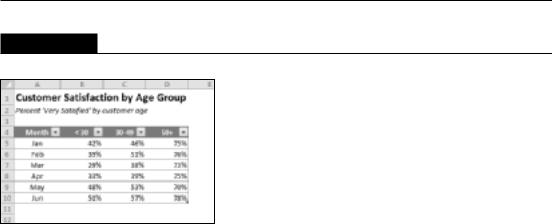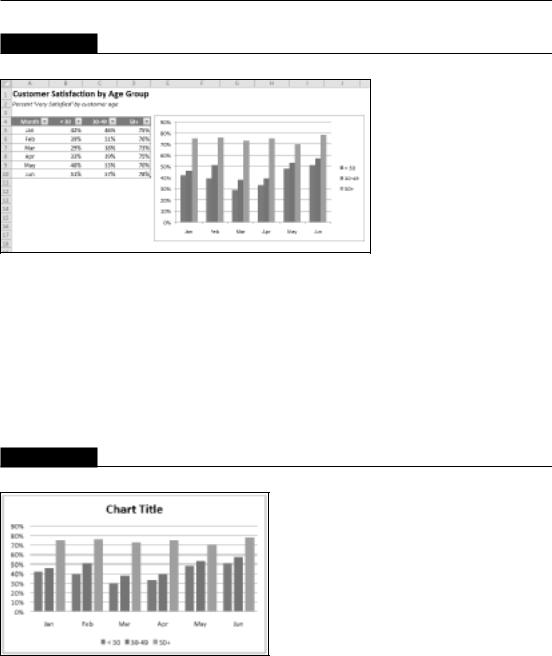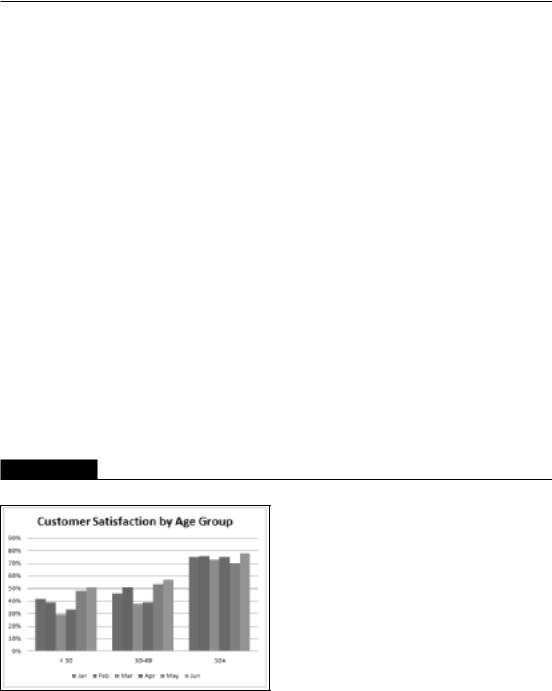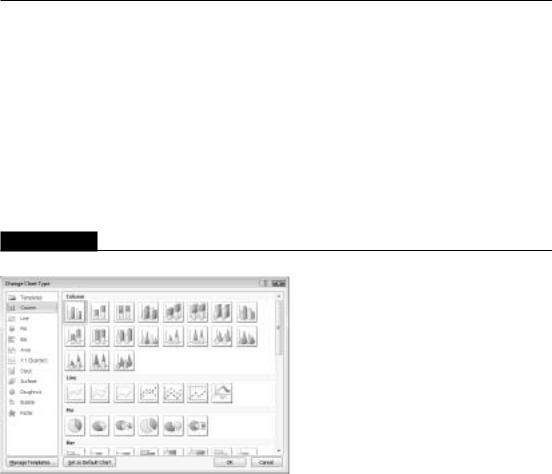
- •About the Author
- •About the Technical Editor
- •Credits
- •Is This Book for You?
- •Software Versions
- •Conventions This Book Uses
- •What the Icons Mean
- •How This Book Is Organized
- •How to Use This Book
- •What’s on the Companion CD
- •What Is Excel Good For?
- •What’s New in Excel 2010?
- •Moving around a Worksheet
- •Introducing the Ribbon
- •Using Shortcut Menus
- •Customizing Your Quick Access Toolbar
- •Working with Dialog Boxes
- •Using the Task Pane
- •Creating Your First Excel Worksheet
- •Entering Text and Values into Your Worksheets
- •Entering Dates and Times into Your Worksheets
- •Modifying Cell Contents
- •Applying Number Formatting
- •Controlling the Worksheet View
- •Working with Rows and Columns
- •Understanding Cells and Ranges
- •Copying or Moving Ranges
- •Using Names to Work with Ranges
- •Adding Comments to Cells
- •What Is a Table?
- •Creating a Table
- •Changing the Look of a Table
- •Working with Tables
- •Getting to Know the Formatting Tools
- •Changing Text Alignment
- •Using Colors and Shading
- •Adding Borders and Lines
- •Adding a Background Image to a Worksheet
- •Using Named Styles for Easier Formatting
- •Understanding Document Themes
- •Creating a New Workbook
- •Opening an Existing Workbook
- •Saving a Workbook
- •Using AutoRecover
- •Specifying a Password
- •Organizing Your Files
- •Other Workbook Info Options
- •Closing Workbooks
- •Safeguarding Your Work
- •Excel File Compatibility
- •Exploring Excel Templates
- •Understanding Custom Excel Templates
- •Printing with One Click
- •Changing Your Page View
- •Adjusting Common Page Setup Settings
- •Adding a Header or Footer to Your Reports
- •Copying Page Setup Settings across Sheets
- •Preventing Certain Cells from Being Printed
- •Preventing Objects from Being Printed
- •Creating Custom Views of Your Worksheet
- •Understanding Formula Basics
- •Entering Formulas into Your Worksheets
- •Editing Formulas
- •Using Cell References in Formulas
- •Using Formulas in Tables
- •Correcting Common Formula Errors
- •Using Advanced Naming Techniques
- •Tips for Working with Formulas
- •A Few Words about Text
- •Text Functions
- •Advanced Text Formulas
- •Date-Related Worksheet Functions
- •Time-Related Functions
- •Basic Counting Formulas
- •Advanced Counting Formulas
- •Summing Formulas
- •Conditional Sums Using a Single Criterion
- •Conditional Sums Using Multiple Criteria
- •Introducing Lookup Formulas
- •Functions Relevant to Lookups
- •Basic Lookup Formulas
- •Specialized Lookup Formulas
- •The Time Value of Money
- •Loan Calculations
- •Investment Calculations
- •Depreciation Calculations
- •Understanding Array Formulas
- •Understanding the Dimensions of an Array
- •Naming Array Constants
- •Working with Array Formulas
- •Using Multicell Array Formulas
- •Using Single-Cell Array Formulas
- •Working with Multicell Array Formulas
- •What Is a Chart?
- •Understanding How Excel Handles Charts
- •Creating a Chart
- •Working with Charts
- •Understanding Chart Types
- •Learning More
- •Selecting Chart Elements
- •User Interface Choices for Modifying Chart Elements
- •Modifying the Chart Area
- •Modifying the Plot Area
- •Working with Chart Titles
- •Working with a Legend
- •Working with Gridlines
- •Modifying the Axes
- •Working with Data Series
- •Creating Chart Templates
- •Learning Some Chart-Making Tricks
- •About Conditional Formatting
- •Specifying Conditional Formatting
- •Conditional Formats That Use Graphics
- •Creating Formula-Based Rules
- •Working with Conditional Formats
- •Sparkline Types
- •Creating Sparklines
- •Customizing Sparklines
- •Specifying a Date Axis
- •Auto-Updating Sparklines
- •Displaying a Sparkline for a Dynamic Range
- •Using Shapes
- •Using SmartArt
- •Using WordArt
- •Working with Other Graphic Types
- •Using the Equation Editor
- •Customizing the Ribbon
- •About Number Formatting
- •Creating a Custom Number Format
- •Custom Number Format Examples
- •About Data Validation
- •Specifying Validation Criteria
- •Types of Validation Criteria You Can Apply
- •Creating a Drop-Down List
- •Using Formulas for Data Validation Rules
- •Understanding Cell References
- •Data Validation Formula Examples
- •Introducing Worksheet Outlines
- •Creating an Outline
- •Working with Outlines
- •Linking Workbooks
- •Creating External Reference Formulas
- •Working with External Reference Formulas
- •Consolidating Worksheets
- •Understanding the Different Web Formats
- •Opening an HTML File
- •Working with Hyperlinks
- •Using Web Queries
- •Other Internet-Related Features
- •Copying and Pasting
- •Copying from Excel to Word
- •Embedding Objects in a Worksheet
- •Using Excel on a Network
- •Understanding File Reservations
- •Sharing Workbooks
- •Tracking Workbook Changes
- •Types of Protection
- •Protecting a Worksheet
- •Protecting a Workbook
- •VB Project Protection
- •Related Topics
- •Using Excel Auditing Tools
- •Searching and Replacing
- •Spell Checking Your Worksheets
- •Using AutoCorrect
- •Understanding External Database Files
- •Importing Access Tables
- •Retrieving Data with Query: An Example
- •Working with Data Returned by Query
- •Using Query without the Wizard
- •Learning More about Query
- •About Pivot Tables
- •Creating a Pivot Table
- •More Pivot Table Examples
- •Learning More
- •Working with Non-Numeric Data
- •Grouping Pivot Table Items
- •Creating a Frequency Distribution
- •Filtering Pivot Tables with Slicers
- •Referencing Cells within a Pivot Table
- •Creating Pivot Charts
- •Another Pivot Table Example
- •Producing a Report with a Pivot Table
- •A What-If Example
- •Types of What-If Analyses
- •Manual What-If Analysis
- •Creating Data Tables
- •Using Scenario Manager
- •What-If Analysis, in Reverse
- •Single-Cell Goal Seeking
- •Introducing Solver
- •Solver Examples
- •Installing the Analysis ToolPak Add-in
- •Using the Analysis Tools
- •Introducing the Analysis ToolPak Tools
- •Introducing VBA Macros
- •Displaying the Developer Tab
- •About Macro Security
- •Saving Workbooks That Contain Macros
- •Two Types of VBA Macros
- •Creating VBA Macros
- •Learning More
- •Overview of VBA Functions
- •An Introductory Example
- •About Function Procedures
- •Executing Function Procedures
- •Function Procedure Arguments
- •Debugging Custom Functions
- •Inserting Custom Functions
- •Learning More
- •Why Create UserForms?
- •UserForm Alternatives
- •Creating UserForms: An Overview
- •A UserForm Example
- •Another UserForm Example
- •More on Creating UserForms
- •Learning More
- •Why Use Controls on a Worksheet?
- •Using Controls
- •Reviewing the Available ActiveX Controls
- •Understanding Events
- •Entering Event-Handler VBA Code
- •Using Workbook-Level Events
- •Working with Worksheet Events
- •Using Non-Object Events
- •Working with Ranges
- •Working with Workbooks
- •Working with Charts
- •VBA Speed Tips
- •What Is an Add-In?
- •Working with Add-Ins
- •Why Create Add-Ins?
- •Creating Add-Ins
- •An Add-In Example
- •System Requirements
- •Using the CD
- •What’s on the CD
- •Troubleshooting
- •The Excel Help System
- •Microsoft Technical Support
- •Internet Newsgroups
- •Internet Web sites
- •End-User License Agreement

Part III: Creating Charts and Graphics
Creating a Chart
Creating a chart is fairly simple:
1.Make sure that your data is appropriate for a chart.
2.Select the range that contains your data.
3.Choose Insert Charts and select a chart type. These icons display drop-down lists that display subtypes. Excel creates the chart and places it in the center of the window.
4.(Optional) Use the commands in the Chart Tools contextual menu to change the look or layout of the chart or add or delete chart elements.
Tip
You can create a chart with a single keystroke. Select the range to be used in the chart and then press Alt+F1 (for an embedded chart) or F11 (for a chart on a chart sheet). Excel displays the chart of the selected data, using the default chart type. The default chart type is a column chart, but you can change it. Start by creating a chart of the type that you want to be the default type. Select the chart and choose Chart Tools Design Change Chart Type. In the Change Chart Type dialog box, click Set As Default Chart. n
Hands On: Creating and
Customizing a Chart
This section contains a step-by-step example of creating a chart and applying some customizations. If you’ve never created a chart, this is a good opportunity to get a feel for how it works.
Figure 18.4 shows a worksheet with a range of data. This data is customer survey results by month, broken down by customers in three age groups. In this case, the data resides in a table (created by choosing Insert Tables Table), but that’s not a requirement to create a chart.
On the CD
This workbook, named hands-on example.xlsx, is available on the companion CD-ROM. n
Selecting the data
The first step is to select the data for the chart. Your selection should include such items as labels and series identifiers (row and column headings). For this example, select the range A4:D10. This range includes the category labels but not the title (which is in A1).
408

Chapter 18: Getting Started Making Charts
FIGURE 18.4
The source data for the hands-on chart example.
Tip
If your chart data is in a table (or is in a rectangular range separated from other data), you can select just a single cell. Excel will almost always guess the range for the chart accurately. n
Note
The data that you use in a chart need not be in contiguous cells. You can press Ctrl and make a multiple selection. The initial data, however, must be on a single worksheet. If you need to plot data that exists on more than one worksheet, you can add more series after the chart is created. In all cases, however, data for a single chart series must reside on one sheet. n
Choosing a chart type
After you select the data, select a chart type from the Insert Charts group. Each control in this group is a drop-down list, which lets you further refine your choice by selecting a subtype.
For this example, choose Insert Charts Column Clustered Column. In other words, you’re creating a column chart, using the clustered column subtype. Excel displays the chart shown in Figure 18.5.
You can move the chart by dragging any of its borders. You can also resize it by clicking and dragging in one of its corners.
Experimenting with different layouts
The chart looks pretty good, but it’s just one of several predefined layouts for a clustered column chart.
To see some other configurations for the chart, select the chart and apply a few other layouts in the Chart Tools Design Chart Layouts group.
409

Part III: Creating Charts and Graphics
FIGURE 18.5
A clustered columns chart.
Note
Every chart type has a set of layouts that you can choose from. A layout contains additional chart elements, such as a title, data labels, axes, and so on. You can add your own elements to your chart, but often, using a predefined layout saves time. Even if the layout isn’t exactly what you want, it may be close enough that you need to make only a few adjustments. n
Figure 18.6 shows the chart after selecting a layout that adds a chart title and moves the legend to the bottom. The chart title is a text element that you can select and edit (the figure shows the generic title). For this example, Customer Satisfaction by Age Group is a good title.
FIGURE 18.6
The chart, after selecting a different layout.
410

Chapter 18: Getting Started Making Charts
Tip
You can link the chart title to a cell so the title always displays the contents of a particular cell. To create a link to a cell, click the chart title, type an equal sign (=), click the cell, and press Enter. Excel displays the link in the Formula bar. In the example, the contents of cell A1 is perfect for the chart title. n
Experiment with the Chart Tools Layout tab to make other changes to the chart. For example, you can remove the grid lines, add axis titles, relocate the legend, and so on. Making these changes is easy and fairly intuitive.
Trying another view of the data
The chart, at this point, shows six clusters (months) of three data points in each (age groups). Would the data be easier to understand if you plotted the information in the opposite way?
Try it. Select the chart and then choose Chart Tools Design Data Switch Row/Column. Figure 18.7 shows the result of this change. I also selected a different layout, which provides more separation between the three clusters.
Note
The orientation of the data has a drastic effect on the look of your chart. Excel has its own rules that it uses to determine the initial data orientation when you create a chart. If Excel’s orientation doesn’t match your expectation, it’s easy enough to change. n
The chart, with this new orientation, reveals information that wasn’t so apparent in the original version. The <30 and 30–49 age groups both show a decline in satisfaction for March and April. The 50+ age group didn’t have this problem, however.
FIGURE 18.7
The chart, after changing the row and column orientation, and choosing a different layout.
411

Part III: Creating Charts and Graphics
Trying other chart types
Although a clustered column chart seems to work well for this data, there’s no harm in checking out some other chart types. Choose Design Type Change Chart Type to experiment with other chart types. This command displays the Change Chart Type dialog box, shown in Figure 18.8. The main categories are listed on the left, and the subtypes are shown as icons. Select an icon and click OK, and Excel displays the chart using the new chart type. If you don’t like the result, select Undo.
Tip
You can also change the chart type by selecting the chart and using the controls in the Insert Charts group. n
FIGURE 18.8
Use this dialog box to change the chart type.
Trying other chart styles
If you’d like to try some of the prebuilt chart styles, select the chart and choose Chart Tools Design Chart Styles gallery. You’ll find an amazing selection of different colors and effects, all available with a single mouse click.
Tip
The styles displayed in the gallery depend on the workbook’s theme. When you choose Page Layout Themes Themes to apply a different theme, you’ll have a new selection of chart styles designed for the selected theme. n
412
